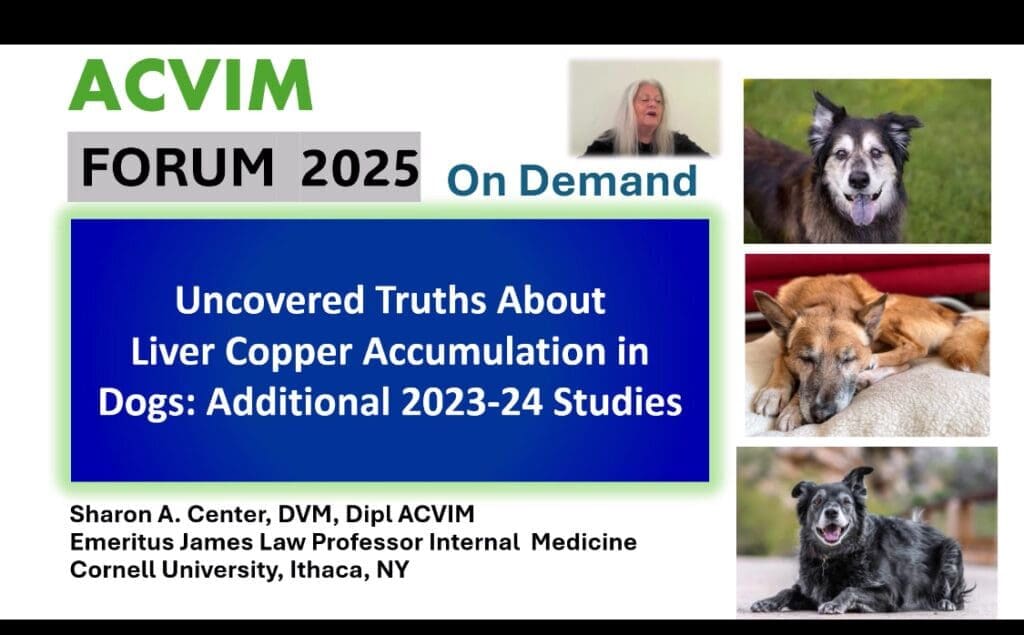Top Cornell Veterinarian Quietly Drops Another Dog Food Bombshell
Alarming New Data Shows There's Too Much Copper In Commercial Dog Diets -- And It's Putting Millions Of Dogs At Risk
This past June, Dr. Sharon Center, a world-renowned veterinarian at Cornell, quietly unveiled new data at a conference she says led her to estimate that approximately 12 million U.S. dogs 9 and older are in imminent danger of liver disease (canine copper storage disease or CAH) due to excess copper levels in many commercial pet diets.
There’s too much copper in dog food, Dr. Center, a professor of Internal Medicine at Cornell’s College of Veterinary Medicine has been warning for years with several other respected colleagues, most notably in a 2021 JAVMA article here. But earlier this summer, at a conference in June The Canine Review attended virtually, Dr. Center debuted alarming new data from three of her latest studies, which are still pending publication, about excess copper levels in commercial dog diets and a causal link to fatal liver disease in dogs. Drawing on her latest research, which also lists several other prominent veterinary internists in the citations, Dr. Center said in the presentation that she now estimates that more than 12 million U.S. dogs are impacted by dangerous copper levels in their diets.
Dr. Center began the presentation with a refutation of points made by pet food industry stakeholders, lobbyists, and associates of industry who have, so far, successfully pushed back on recommendations from Dr. Center and other scientists to limit the levels of copper in dog diets.
Here’s how she began her presentation:
“Over the next hour, I’ll share with you, new case-based studies we hope will encourage the FDA regulatory officials to reconsider minimum and maximum copper allowances for commercial dog foods, as well as labeling modifications that will help inform veterinarians and pet owners of the actual copper concentrations in marketed products.”
One of the three studies she outlines describes an exhaustive process to collect data for individual liver biopsy submissions to Cornell over the course of one year. “I ask for a photo of the label, the flavors, any treats, commercial versus human food, explicitly characterized, supplements, the brand source, ingredients…so that we can ascertain what the copper content is [in a dog’s diet],” she explains regarding the collection of information about the dog’s diet history. Even copper in a dog’s water source(s) is carefully documented.
“Case based findings implicate a harmful impact of common dietary copper concentrations in commercial dog foods during these years,” Dr. Center told the ACVIM audience.
Asked about the presentation, Dr. Center underscored in an email to TCR that the data she presented at the Forum is still pending peer review:
“The information I presented at the Forum is a summary of papers submitted for publication that are currently in review,” Dr. Center wrote. “I have worked diligently to complete these studies and would be offended by you usurping my primary communication with FDA-CVM and reporting what might misconstrue our findings,” she added.
However, without detailing Dr. Center’s data, we can say that the data provide important new findings showing a causal link between commercial dog diets and dangerous copper liver concentrations indicating liver disease.
A Four-Year Debate
Close followers of the “copper in dog food” saga would likely pinpoint the genesis of the controversy to Dr. Center’s February 2021 Journal of the American Veterinary Medical Association (JAVMA) editorial, “Is it time to reconsider current guidelines for copper content in commercial foods?” In the article, Dr. Center summarized her decades of research and why it has led her to conclude that there is a causal relationship between a notable rise an often fatal dog liver disease called copper-associated hepatopathy and an increase in copper concentration levels in commercial dog foods. Dr. Center contended then – and now — that this is largely because of changes to the guidelines promulgated by the Association of American Feed Control Officials (AAFCO) in 1997 — specifically the implementation of a copper minimum for dog food, which Dr. Center and her colleagues argue has caused a lot of harm, and no notable benefit.
HHS Senior Advisor Calley Means Declines to Comment on Pet Food Labeling Requirements
Calley Means a senior advisor to Health and Human Services Secretary Robert F. Kennedy, Jr. did not respond to requests for comment when asked for the Trump administration’s response to Dr. Center’s policy recommendations, which would seem to line up squarely with the new “Make America Healthy Again” policy initiative of “radical transparency” with respect to food labeling. Dr. Center’s recommendation would require pet food firms to display, in plain, simple English on the packaging, exactly how much copper is in a particular diet.
Andrew Nixon, the chief spokesman for the department, also did not return requests for comment.
As this story was going to press, Dr. Center did not return a request for comment seeking an update on when or where this data would be published, but when TCR spoke with Dr. Center days after her presentation in June, she said she expected to have the work published soon in the Journal of the American Veterinary Medical Association (JAVMA).
Related:
Pet Industry Declines to Limit Soaring Copper Levels in Dog Food

